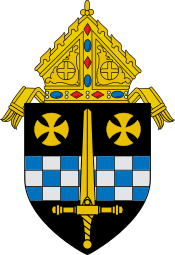Hugh Charles Boyle
| The Most Reverend Hugh Charles Boyle | |
|---|---|
| Bishop of Pittsburgh | |
 A stained-glass depiction of Bishop Boyle located in Saint Patrick Church in Canonsburg, Pennsylvania | |
| See | Pittsburgh |
| Installed | June 29, 1921 |
| Term ended | December 22, 1950 |
| Orders | |
| Ordination | July 2, 1898 |
| Consecration | June 29, 1921 |
| Personal details | |
| Born |
October 8, 1873 Johnstown, Pennsylvania |
| Died |
December 22, 1950 (aged 77) Pittsburgh, Pennsylvania |
| Denomination | Roman Catholic Church |
| Coat of arms |
|
Hugh Charles Boyle (October 8, 1873 – December 22, 1950) was an American prelate of the Roman Catholic Church. He served as Bishop of Pittsburgh from 1921 until his death in 1950.
Biography
Hugh Boyle was born in Johnstown, Pennsylvania, one of nine children of Charles and Anna (née Keelan) Boyle.[1] His father was an Irish immigrant who worked as a coal miner.[2] He received his early education at local parochial schools, and enrolled at St. Vincent College in Latrobe at age 14.[3] During the 1889 Johnstown Flood, his father and most of his siblings drowned; only his mother and one brother survived.[4] He began his studies for the priesthood at St. Vincent Seminary, also in Latrobe, in 1891.[1]
Boyle was ordained a priest by Bishop Richard Phelan on July 2, 1898.[5] His first assignment was as a curate at St. Aloysius Church in Wilmerding, where he remained for five years.[1] He then served at the Cathedral of St. Paul and secretary to Bishop Regis Canevin until 1909, when he became superintendent of diocesan schools.[2] From 1916 to 1921, he served as pastor of St. Mary Magdalene Church in Homestead.[1]
On June 16, 1921, Boyle was appointed the sixth Bishop of Pittsburgh by Pope Benedict XV.[5] He received his episcopal consecration on the following June 29 from Bishop Canevin, with Bishops Philip R. McDevitt and John Joseph McCort serving as co-consecrators.[5] During his 29-year tenure, he earned a reputation as one of the leading Catholic educators in the nation, and sponsored a comprehensive school-building program in the diocese,[2] most notably asking the Brothers of the Christian Schools to establish Central Catholic High School. He was a strong supporter of social justice movements, such as the Catholic Radical Alliance.[6] In 1941, he established the Catholic Workers' School in Pittsburgh.[2]
During World War II, Boyle served as chairman of the National Catholic Welfare Council's Committee for Polish Relief.[2] He defended the Allied bombing of Rome as a wartime necessity and praised the care that was taken in the air raids to protect the city's religious and cultural treasures.[2] Boyle also played a prominent role in the activities of the Legion of Decency and was a member of the Episcopal Committee on Motion Pictures.[2]
Boyle died at Mercy Hospital in Pittsburgh, at age 77.[2] He is buried in St. Mary Cemetery in the city's Lawrenceville neighborhood.[7]
References
- 1 2 3 4 Curtis, Georgina Pell (1947). The American Catholic Who's Who. VII. Grosse Pointe, Michigan: Walter Romig.
- 1 2 3 4 5 6 7 8 "BISHOP H.C. BOYLE OF PITTSBURGH, 77; Diocesan Head 29 Years Dies—Noted Educator Had Long Aided Cause of Labor". The New York Times. 1950-12-23.
- ↑ O'Donnell, John Hugh (1922). The Catholic Hierarchy of the United States, 1790-1922. Washington, D.C.
- ↑ "The Johnstown, Pennsylvania, Flood 31 May 1889". Donegal Genealogy Resources.
- 1 2 3 "Bishop Hugh Charles Boyle". Catholic-Hierarchy.org.
- ↑ "Radical Alliance' Priests Strike With Pickets". Pittsburgh Press. Pittsburgh, Pennsylvania. p. 42.
We contend that the relationship between Catholicism and capitalism is one of fundamental opposition
- ↑ "Former Diocesan Bishops". Roman Catholic Diocese of Pittsburgh.
| Catholic Church titles | ||
|---|---|---|
| Preceded by Regis Canevin |
Bishop of Pittsburgh 1921–1950 |
Succeeded by John Dearden |
